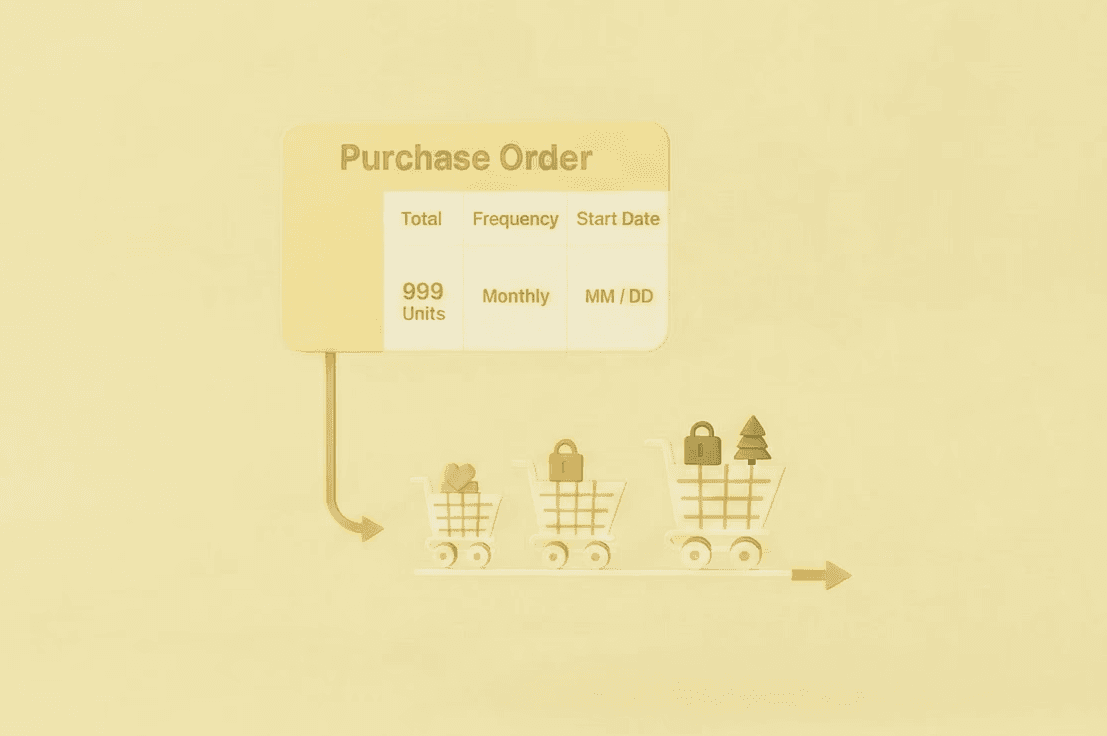Blog
Educational
The Definitive Guide to AI‑Driven SaaS Inventory Optimization
The Definitive Guide to AI‑Driven SaaS Inventory Optimization
Laura B
Marketing Analyst
Oct 16, 2025
You need AI in inventory today because demand is noisy, supply is unreliable, and cash is expensive. Spreadsheets and fixed ERP rules assume the future looks like the past and that you have one stockroom and unlimited time. Reality is multi-channel, multi-location, promotion-driven, and full of supplier hiccups. AI systems don’t just calculate—they watch, learn, and act: they turn messy data into per-SKU, per-location forecasts, rank what to buy within your budget, build approval-ready POs, suggest transfers before you overspend, and publish honest delivery windows customers can trust.
Mini-Glossary
Safety Stock: Buffer inventory to absorb demand and lead-time variability.
Service Level: Probability of not stocking out in a period (e.g., 95%).
Fill Rate: % of demand fulfilled on time from available stock.
Lead-Time Distribution: Probabilistic view of how long replenishment takes.
Why Inventory Optimization Needs AI—Now
Demand moves like weather, not a calendar.
A TikTok mention today, a price match tomorrow, a heatwave next week—your top SKU can whiplash in hours. AI models detect these pulses and adjust daily; manual averages react after the damage.Supply is uncertain by design.
Port delays, component shortages, vendor switches—lead times aren’t a number; they’re a distribution. AI reasons in ranges (10–14 days, p=0.7) and protects your promise without stuffing cash into safety stock.You sell in five places, not one.
Website, Amazon, eBay, stores, wholesale. Each channel cannibalizes and amplifies the others differently. AI learns cross-channel effects so you don’t starve one to feed another.Your cash has a cost.
Stock is a bet. AI ranks bets by expected revenue saved and margin, inside a weekly budget cap. That’s how ops and finance become allies, not adversaries.Humans are amazing—but not at 30,000 tiny math problems.
Ask your team to review exceptions and negotiate, not re-key reorder points. AI handles the math and the mundane; people handle the judgment.
What “AI-Driven” Actually Means
An AI inventory OS isn’t a dashboard; it’s a closed loop that gets smarter every week:
Forecast — The system decomposes demand into trend, seasonality, promotions, and stockout artifacts. It assigns confidence and explains drivers in plain English (e.g., “Seasonality +18%, Promo lift +12%”).
Replenish — It ranks SKUs by days to stockout, expected lost sales, margin, and risk—per location—and respects reality (MOQs, case packs, capacity, in-transit, vendor performance).
Buy — It composes approval-ready POs by supplier, with price breaks and lead-time logic, and keeps line-level diffs so finance can audit changes.
Fulfill & Learn — Inbound PO ETAs feed your storefront and 3PL to show “Ships by Nov 7–10” instead of “Out of stock.” Actuals roll back to the model to reduce bias next week.
Key idea: It’s not just faster—it’s compounding. Every cycle reduces error and waste.
Data Foundations You Need
AI performance depends on clean inputs. Aim for:
Sales & inventory history: At least 12–18 months for core SKUs.
Product metadata: Variants, hierarchies, substitutions, bundles.
Supplier data: Lead times (average & variability), MOQs, case packs, price tiers, incoterms.
Channel & promo events: Discounts, drops, influencer dates, merch calendar.
Fulfillment signals: Receipts, ASN dates, on-time rates, cancellations.
Treat missing or noisy data as a first-class problem: fill gaps, flag anomalies, and version everything. Good data hygiene outperforms aggressive modeling every time.
Forecasting: From Averages to Pattern Detection
Classic methods (simple moving average, fixed safety stock) assume “tomorrow ≈ yesterday.” AI systems decompose demand into components and quantify uncertainty:
Trend & seasonality: Weekly and holiday peaks, shoulder effects after promos.
Causal lifts: Price changes, discounts, influencer campaigns, and stockouts (removing false zeros).
New SKU inference: Borrow patterns from parent category and sibling variants.
Lead-time awareness: Forecast to receipt windows, not just order dates.
What to demand from your platform: per-SKU driver attributions (“seasonality +18%, promo +12%”), forecast confidence bands, and transparent failure modes (e.g., “insufficient history—using category proxy”).
Replenishment: Ranked Decisions, Not Guesswork
You don’t need another table of reorder points—you need a clear daily/weekly buy list:
Priority score: Combines days to stockout, expected lost revenue, gross margin, and uncertainty.
Cash alignment: Budget-aware recommendations buy the highest ROI units first.
Operational reality: MOQs, case packs, warehouse capacity, and in-transit inventory all respected.
Exception management: You review only the outliers; the median cases flow.
This “ranked SKU” approach shifts the team from reactive firefighting to proactive approvals.
Purchase Orders: Approval-Ready Automation
POs should assemble themselves:
Supplier profiles: Terms, price breaks, standard lead times, and performance history.
Auto-bundling: Group lines intelligently per vendor while honoring MOQs/case packs.
Change tracking: Line-level diffs with who approved what and when (audit-ready).
Budget guardrails: Cap total PO value by week or month; surface trade-offs explicitly.
Automation doesn’t remove control; it removes busywork so humans focus on negotiation and exceptions.
“Always Selling”: Backorders with Honest ETAs
Turning on backorders without reliable ETAs is a churn trap. Tie your storefront promises to live PO data:
ETA windows: “Ships by Nov 7–10” sets expectations better than “Out of stock.”
Prioritization: Allocate first receipts to paid backorders; route the remainder to general stock.
Proactive comms: Update customers when PO dates shift; offer alternatives when risk spikes.
Done right, backorders convert “come back later” into captured demand today—and prove the value of your forecasting loop to the business.
KPIs That Prove It Works
Track a short list that connects planning to cash and customer experience:
Stockout rate (sessions or orders impacted)
Fill rate & on-time delivery
Revenue saved from avoided stockouts + backorders fulfilled
Weeks of supply by class (A/B/C)
PO cycle time (request → approval → send)
Cash in slow movers and aging profile
Review monthly with a simple governance ritual: model drift, supplier scorecards, and playbook updates.
A 90-Day Rollout Plan
Weeks 0–2: Connect & Clean
Integrate commerce, WMS/3PL, and accounting. Import suppliers and map lead times. Fix obvious data gaps.
Weeks 3–4: Forecast Validation
Audit top 100 SKUs by revenue. Compare model vs. actuals; note where proxies or human overrides are needed.
Weeks 5–8: Replenishment Pilot
Turn on ranked recommendations for high-velocity SKUs. Approve POs weekly with a fixed budget cap. Track stockout rate and PO cycle time.
Weeks 9–12: Close the Loop
Enable backorders with ETA windows fed by inbound POs. Expand automation tiers, document SOPs, and set monthly model reviews.
Common Pitfalls (and How to Avoid Them)
Static lead times: Use distributions—not single numbers—especially for overseas vendors.
Over-automation: Keep humans in the loop for low-confidence or high-value buys.
Ignoring cannibalization: New variants often borrow demand; adjust plans accordingly.
No budget guardrails: Great forecasts can still break cash. Bake finance into the algorithm.
Set-and-forget: Models drift. Schedule recurring audits and supplier feedback.
FAQs
Is AI overkill for <5,000 SKUs?
No. Ranked replenishment and PO automation deliver outsized gains at any scale—start with your top sellers.
What if our data is messy?
Begin with the cleanest 100 SKUs, establish data contracts, and expand. Data hygiene compounds.
How do we justify this to finance?
Report revenue saved, cash tied in slow movers, and PO cycle-time reduction. Tie recommendations to budget caps.
Will backorders hurt CX?
Not if ETAs are accurate and proactive updates are standard. Honesty beats “Out of stock.”
Laura B
Marketing Analyst
Share






